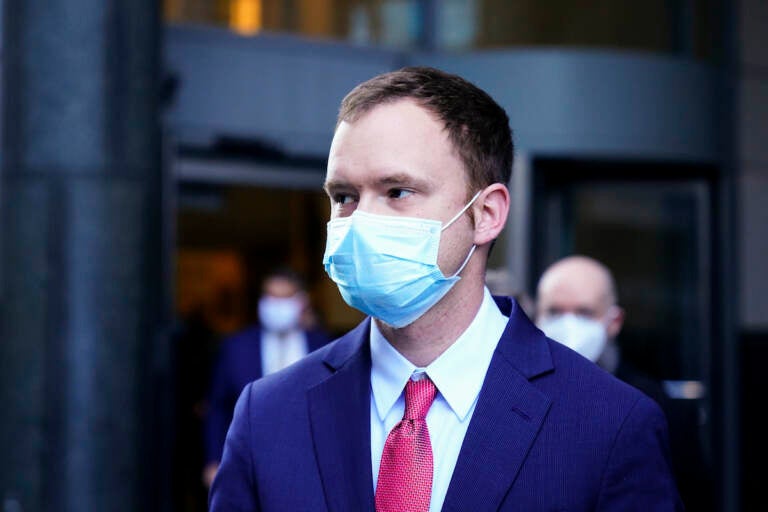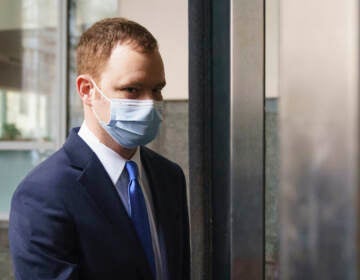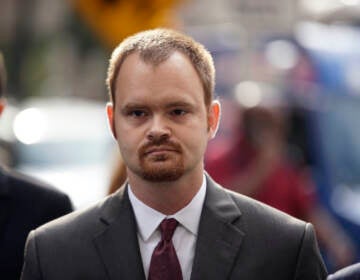‘Human’ error or ‘knowing’ recklessness? Jury to decide Amtrak engineer’s fate
In closing statements, prosecutors argued that Bostian “knew where he was” but accelerated his train anyway, while the defense urged understanding for a mistake.

Brandon Bostian, the Amtrak engineer involved in a 2015 derailment in Philadelphia that killed eight people and injured more than 200, walks from the criminal justice center in Philadelphia, Thursday, March 3, 2022. (AP Photo/Matt Rourke)
The case against former Amtrak engineer Brian Bostian is in the jury’s hands, after five days of witness testimony and arguments.
They must decide whether he knowingly disregarded a “substantial and unjustified risk” when he accelerated his train to twice the speed limit around a sharp curve at Frankford Junction, the night of May 12, 2015.
In closing statements, prosecutors argued that Bostian “knew where he was” but accelerated his train anyway, while the defense urged understanding for a mistake.
“We’re all human,” said Bostian attorney Brian McMonagle.
The ensuing derailment killed eight people and sent nearly 200 others to the hospital. Bostian faces charges of causing catastrophe, involuntary manslaughter, and reckless endangerment. If convicted, he faces “more than a lifetime of incarceration,” said Judge Barbara McDermott.
Throughout the week, witnesses for both sides testified to all of the possible reasons Bostian might speed, but which do not explain his actions in this case.
A federal investigation by the National Transportation Safety Board found no evidence of mechanical failure. Blood and urine samples came back clean for drugs and alcohol. Bostian’s driving history was spotless, and that night he was not asleep, as evidenced by the train’s event recorder, which showed him operating it up to the derailment.
Bostian did not take the stand in his own defense.
That leaves the jury to decide what was going through his mind as he pushed the throttle forward on a straightaway in North Philadelphia.
In closing statements, defense attorney Brian McMonagle argued that Bostian was an “excellent engineer” with a “perfect” record, who was distracted through no fault of his own.
Two other trains were struck by projectiles in the area that night. As Bostian wound his way through North Philadelphia, he listened to six minutes of radio chatter between the engineer of SEPTA train no. 769, and dispatchers, according to investigation records. Some of those radio transmissions dealt with whether engineer Curtis Parrish needed medical attention because his windshield had shattered and glass was thrown in his face.
A second engineer, Herbert Harris, radioed that his train, Acela no. 2173, had been “shot at.”
McMonagle blamed “criminals … out there in the darkness” for creating the distraction that led to the deaths of eight people on Bostian’s train. “Good men should not have to sit on trial for the evil that other men do,” he continued.
This chatter, the defense argued, caused Bostian to lose track of where he was, and accelerate to the speed he was supposed to go just after the Frankford Curve, in a longer straightaway.
Looking at records of Bostian’s other trips, “the only thing that changed, compared to any other night, is the emergency broadcasts,” said Timothy Hicks, a consultant and expert in accident reconstruction called as the final witness for the defense on Thursday.
Senior deputy attorney general Christopher Phillps called these reasons “excuses.”
He argued that the law requires Bostian’s actions to be compared to those of other locomotive engineers, who are all held to a high standard. During the trial, several witnesses who are or had been in that position testified that rock-throwing is far more common than running off the track.
As evidence of that, the two engineers who actually dealt with projectiles the night of the incident “did not deviate” from that standard and derail their trains, argued Phillips.
Phillips also drew attention to “contradictory and deceptive statements” Bostian made the night of the derailment.
At the scene of the incident, Amtrak 188 passenger Blair Berman had testified that Bostian identified their location as Frankford Junction when she was on the phone with her father. Another witness, Philadelphia Police detective Joseph Knoll, testified that Bostian had asked staff at Einsteinstein Hospital, where he was taken for treatment, “Am I in New York?”
Bostian’s perfect performance up to the derailment only goes to show that he was aware of his location, argued Phillips.
“Despite knowing where he was, Frankford Curve, he accelerated for 33 seconds,” said the prosecutor.
Phillips urged the jury to find him guilty and give the families of those who died that night the “justice they deserve” after years of waiting.
Twice in the seven years since the derailment, judges had tossed out the charges. In response to a defense motion to once again dismiss on Thursday, Judge McDermott, who had previously thrown it out, said she would let the jury deliberate but would reserve a final judgment until after the verdict.
Deliberations resume Friday morning.
WHYY is your source for fact-based, in-depth journalism and information. As a nonprofit organization, we rely on financial support from readers like you. Please give today.




